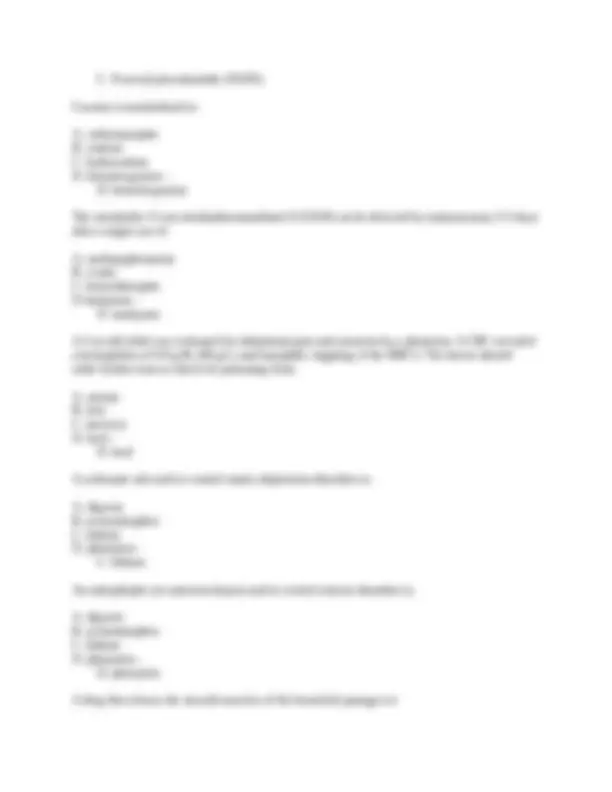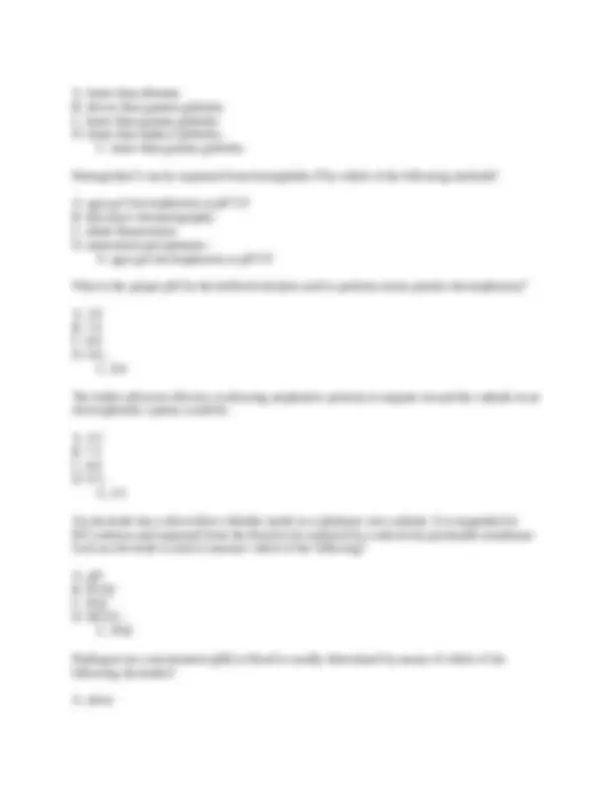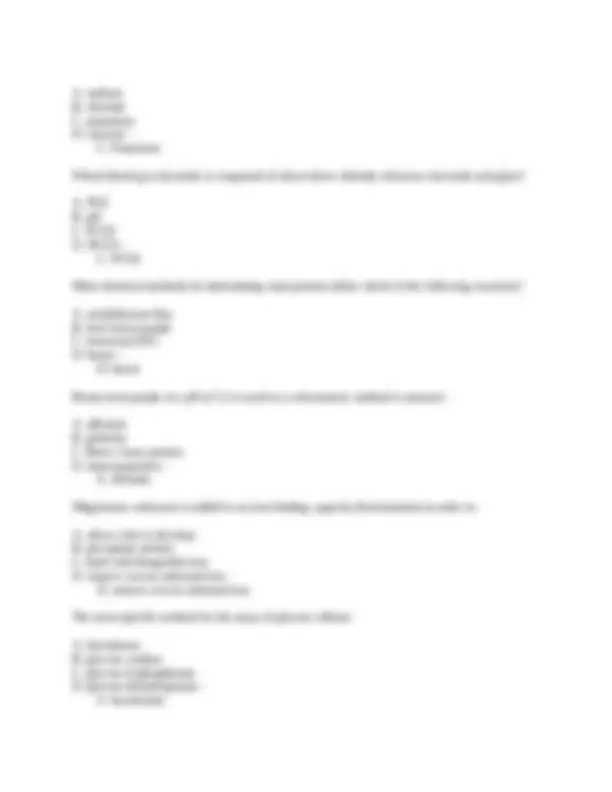










Study with the several resources on Docsity

Earn points by helping other students or get them with a premium plan


Prepare for your exams
Study with the several resources on Docsity

Earn points to download
Earn points by helping other students or get them with a premium plan
Community
Ask the community for help and clear up your study doubts
Discover the best universities in your country according to Docsity users
Free resources
Download our free guides on studying techniques, anxiety management strategies, and thesis advice from Docsity tutors
ASCP-Chemistry section ASCP-Chemistry section
Typology: Exams
1 / 14

This page cannot be seen from the preview
Don't miss anything!









Aldosterone is released by the adrenal cortex upon stimulation by: A. Renin B. Angiotensinogen C. Angiotenisinogen I D. Angiotensinogen II - D. Angiotensinogen II Clinical Assays for tumor markers are most important for: A. screening for the presence of cancer B. monitoring the course of known cancer C. confirming the absence of disease D. identifying patients at risk for cancer - B. Monitoring the course of known cancer Detection of which of the following substances is most useful to monitor the course of a patient with testicular cancer? A. alpha-fetoprotein B. carcinoembryonic antigen C. prolactin D. testosterone - A. alpha-fetoprotein Increased concentrations of alpha-fetoprotein (AFP) in adults are most characteristically associated with: A. hepatocellular carcinoma B. alcoholic cirrhosis C. chronic active hepatitis D. multiple myeloma - A. hepatocellular carcinoma Carcinoembryonic antigen (CEA) is most likely to be produced in a maignancy involving the: A. Brain B. Testes C. Bone D. Colon - D. Colon Which of the following is useful in the detection an management of carcinoma of the prostate? A. total prostate-specific antigen B. prostatic acid phosphatase
C. human chorionic gonadotropin D. alpha-fetoprotein - A. total prostate-specific antigen Which of the following statements most correctly describes the utility of clinical laboratory assays for tumor markers? A. tumor markers are useful to screen asymptomatic patients for tumors B. tumor markers are highly specific C. tumor markers indicate the likelihood of an individual developing a tumor D. tumors are useful in tracking the efficacy of treatment - D. tumors are useful in tracking the efficacy of treatment Cancer antigen 125 (CA 125) is a tumor marker associated with: A. breast carcinoma B. colon cancer C. lung cancer D. ovarian and endometrial carcinoma - D. ovarian and endometrial carcinoma In addition to carcinoma of the prostate, elevated prostate-specific antigen (PSA) can occur due to: A. aspirin therapy B. exogenous steroid use C. benign prostatic hyperplasia D. statin therapy (cholesterol lowering drugs) - C. benign prostatic hyperplasia A drug has a half-life of 6 hours. If a dose is given every 6 hours, a steady-state drug level would usually be achieved in: A. 3-5 hours B. 10-12 hours C. 24-42 hours D. 48-50 hours - C. 24-42 hours The drug procainamide is prescribed to treat cardiac arrhythmia. What biologically active liver metabolite of procainamide is often measured simultaneously? A. phenobarbitol B. quinidine C. N-acetyl procainamide (NAPA) D. lidocaine -
A. acetaminophen B. lithium C. phenytoin D. theophylline - D. theophylline A cardiac glycoside that is used in the treatment of congenital heart failure and arrythmias by increasing the force and velocity of myocardial contraction is: A. digoxin B. acetaminophen C. lithium D. phenytoin - A. digoxin A salicylate level is performed to detect toxicity caused by ingestion of excess: A. acetaminophen B. aspirin C. ibuprofen D. psuedoephedrine - B. aspirin Lithium therapy is widely used in the treatment of: A. hypertension B. hyperactivity C. aggression D. manic-depressive (bipolar) disorder - D. manic-depressive (bipolar) disorder Testing for the diagnosis of lead poisoning should include: A. erythrocyte protoporphyrin (EPP) B. urine delta-aminolevulinic acid C. whole blood lead D. zinc protoporphyrin (ZPP) - C. whole blood lead Blood received in the laboratory for blood gas analysis must meet which of the following requirements? A. on ice, thin fibrin strands only, no air bubbles B. on ice, no clots, fewer than 4 air bubbles C. on ice, no clots, no air bubbles
D. room temperature, no clots, no air bubbles - C. on ice, no clots, no air bubbles In a specimen collected for plasma glucose analysis, sodium fluoride: A. serves as a coenzyme of hexokinase B. prevents reactivity of non-glucose reducing substances C. precipitates proteins D. inhibits glycolysis - D. inhibits glycolysis As part of a hyperlipidemia screening program, the following results were obtained on a a 25-yr- old woman 6 hours after eating: triglycerides: 260 mg/dL (2.86 mmol/L) cholesterol: 120 mg/dL (3.12 mmol/L) Which is the best interpretation of these results? A. both results are normal and not affected by the recent meal B. cholesterol is normal, but triglycerides are elevated, which may be attributed to the recent meal C. both results are elevated, indicating a metabolic problem in addition to the nonfasting state D. both results are below normal despite the recent meal, indicating a metabolic problem - B. cholesterol is normal, but triglycerides are elevated, which may be attributed to the recent meal Blood was collected in a serum separator tube on a patient who has been fasting since midnight. The time of collection was 7 AM. The laboratory test which should be recollected is: A. triglycerides B. iron C. LD D. sodium - A. triglycerides Unless blood gas measurments are made immediately after sampling, in vitro glycolysis f the blood causes a: A. rise in oH and PCO B. fall in pH and a rise in PO C. rise in pH and a fall in PO D. fall in pH and a rise in PCO2 - D. fall in pH and a rise in PCO Which of the following serum constituents is unstable if a blood specimen is left standing at room temperature for 8 hours before processing?
Which of the following is the Henderson-Hasselbach equation? A. pKa =pH + log ([acid]/[salt]) B. pKa = pH + log ([salt]/[acid]) C. pH = pKa + log ([acid]/[salt]) D. pH = pKa + log ([salt]/[acid]) - D. pH = pKa + log ([salt]/[acid]) The creatinine clearance (mL/min) is equal to: A. urinary creatinine (mg/L)/[volume of urine (mL/min) x plasma creatinine (mg/mL)] B. [urinary creatinine (mg/mL) x volume (mL/min) x plasma creatinine (mg/mL)] C. (urinary creatinine (mg/L))/[volume (mL/hour) x plasma creatinine (mg/L)] D. [urinary creatinine (mg/L) x volume (mL/hour)] / plasma creatinine (mg/mL) - B. [urinary creatinine (mg/L) x volume (mL/min)] / plasma creatinine (mg/L) Normally the bicarbonate concentration is about 24 mEq/L and the carbonic acid concentration is abut 1.2; pK=6.1, log 20=1.3. Using the equation pH=pK + log ([salt]/[acid]), calculate the pH. A. 7. B. 7. C. 7. D. 7.42 - C. 7. Which of the following methods is susceptible to the solvent displacing effect that results in falsely decreased electrolyte values? A. indirect ion-selective electrodes B. direct ion-selective electrodes C. spectrophotometric D. fluorescence - A. indirect ion-selective electrodes To detect barbituate abuse when analyzing urine specimens, immunoassay os the method of choice for screening. The method of choice for confirmation is: A. nephelometry B. thin-layer chromatography C. gas chromatography/mass spectrometry D. ultraviolet absorption spectroscopy - C. gas chromatography/mass spectrometry When separating serum protein by cellulose acetate electrophoresis, using Veronal buffer at pH 8.6, beta globulin migrates:
A. faster than albumin B. slower than gamma globulin C. faster than gamma globulin D. faster than alpha-2 globulin - C. faster than gamma globulin Hemoglobin S can be separated from hemoglobin D by which of the following methods? A. agar gel electrophoresis at pH 5. B. thin-layer chromatography C. alkali denaturation D. ammonium precipitation - A. agar gel electrophoresis at pH 5. What is the proper pH for the buffered solution used to perform serum protein electrophoresis? A. 5. B. 7. C. 8. D. 9.6 - C. 8. The buffer pH most effective at allowing amphoteric proteins to migrate toward the cathode in an electrophoretic system would be: A. 4. B. 7. C. 8. D. 9.5 - A. 4. An electrode has a silver/silver chloride anode an a platinum wire cathode. It is suspended in KCl solution and separated from the blood to be analyzed by a selectively permeable membrane. Such an electrode is used to measure which of the following? A. pH B. PCO C. PO D. HCO3 - C. PO Hydrogen ion concentration (pH) in blood is usually determined by means of which of the following electrodes? A. silver
A. sodium B. chloride C. potassium D. calcium - C. Potassium Which blood gas electrode is composed of silver/silver chloride reference electrode and glass? A. PO B. pH C. PCO D. HCO3 - C. PCO Most chemical methods for determining total protein utilize which of the following reactions? A. molybdenum blue B. ferri-ferrocyanide C. resorcinol-HCl D. biuret - D. biuret Bromcresol purple at a pH of 5.2 is used in a coloremetric method to measure: A. albumin B. globulin C. Bence Jones protein D. immunoprotein - A. albumin Magnesium carbonate is added to an iron binding capacity determination in order to: A. allow color to develop B. precipitate protein C. bind with hemglobin iron D. remove excess unbound iron - D. remove excess unbound iron The most specific method for the assay of glucose utilizes: A. hexokinase B. glucose oxidase C. glucose-6-phosphatase D. glucose dehydrogenase - A. hexokinase
Which of the following calcium procedures utilizes lanthanum chloride to eliminate interfering substances? A. o-cresolphthalein complexone B. precipitation with chloranilic acid C. chelation with EDTA D. atomic absorption spectrophotometry - D. atomic absorption specttrophotometry Before unconjugated bilirubin can react with Ehrlich diazo reagent, which of the following must be added? A. acetone B. ether C. distilled water D. caffeine - D. caffeine The most widely used methods for bilirubin measurement are those based on the: A. Jaffe reaction B. Schales and Schales method C. 8-hydroxyquinoline reaction D. Jendrassik-Grof method - D. Jendrassik-Grof method In the Malloy and Evelyn method for the determination of bilirubin, the reagent that is reacted with bilirubin t form a purple azobilirubin is: A. dilute sulfuric acid B. diazonium sulfate C. sulfobromophthalein D. diazotized sulfanilic acid - D. diazotized sulfanilic acid In the Jendrassik-Grof reaction for total bilirubin, bilirubin reacts wth diazotized sulfanilic acid to form: A. diazo bilirubin B. biliverdin C. azobilirubin D. bilirubin glucurnide - A. diazo bilirubin In the assay of lactate dehydrogenase, which of the following products if actually measured?
A. aldolase B. phosphofructokinase C. pyruvate kinase D. glucose-6-phosphate dehydroxygenase - D. glucose-6-phosphate dehydroxygenase The substance that is measured to estimate the serum concentration of triglycerides by most methods is: A. phospholipids B. glycerol C. fatty acids D. pre-beta lipoprotein - A. phospholipids Which of the following methods for quantitation of high-density lipoprotein is most suitable for clinical laboratory use? A. Gomori procedure B. homogenous C. column chromatography D. agarose gel electrophoresis - B. homogenous A chemiluminescent EIA: A. measure absorption of light B. is less sensistive than radioisotopic reactions C. is monitored by the use of a gamma counter D. is quantitated by the amount of light produced by the reaction - B. is less sensitive than radioisotopic reactions The osmolality of a urine or serum specimen is measured by a change in the: A. freezing point B. sedimentation point C. midpoint D. osmotic pressure - D. osmotic pressure Which of the following applies to cryoscopic osmometry? A. temperature at equilibrium is a function of the number of particles in solution B. temperature plateau for a solution is horizontal C. freezing point of a sample is absolute D. initial freezing of a sample produces an immediate solid state -
A. temperature at equilibrium is a function of the number of particles in solution